The Prince’s Islands, are a chain of nine islands off the coast of Istanbul, Turkey, in the Sea of Marmara, a group of nine islands off the Asian coast of Istanbul, Turkey. Their name is sometimes incorrectly spelled as “Prince’s Islands” or “Princess Islands.”
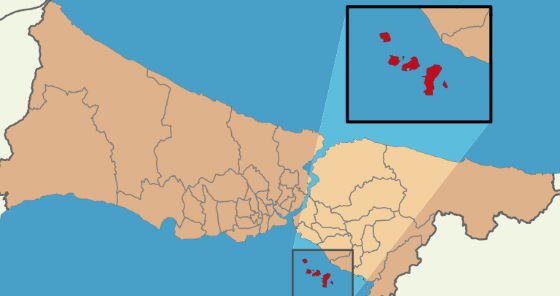
Most İstanbullus refer to the Princes’ Islands as they are the only islands around the city. They lie about 20km southeast of the city in the Sea of Marmara, and make a great destination for a day escape from the city.
You’ll realise after landing that there are no cars on the islands, something that comes as a welcome relief after the traffic mayhem of the city. Except for the necessary police, fire and sanitation vehicles, transportation is by bicycle, horse-drawn carriage and foot, as in centuries past.
All of the islands are busy in summer, particularly on weekends. For that reason, avoid a Sunday visit. If you wish to stay overnight during the summer months, book ahead. Many hotels are closed during winter.
There are nine islands in the Princes Islands group and the ferry stops at four of these. Year round there are 15,000 permanent residents scattered across the six islands that are populated, but numbers swell to 100,000 or so during summer when İstanbullus many of whom have holiday homes on the islands escape the city heat. The small islands of Kınalıada and Burgazada are the ferry’s first stops; frankly, neither offers much reward for the trouble of getting off the ferry.
In contrast, the charming island of Heybeliada has much to offer the visitor. It’s home to the Deniz Lisesi (Turkish Navel Academy), which was founded in 1773, and which you’ll see to the left of the ferry dock as you arrive, and it has a number of restaurants and a thriving shopping strip with bakeries and delicatessens selling picnic provisions to day-trippers, who come here on weekends to walk in the pine groves and swim from the tiny (but crowded) beaches.
The island’s major landmark is the hilltop Hagia Triada Monastery (%351 8563). Perched above a picturesque line of poplar trees in a spot that has been occupied by a Greek monastery since Byzantine times, this building dates from 1894. It functioned as a Greek Orthodox theological school until 1971, when it was closed on the government’s orders, and has an internationally renowned library. There are signs that it may re-open soon. You may be able to visit if you call ahead.
The largest island in the group, Büyükada (Great Island) shows is impressive from the ferry, with gingerbread villas climbing up the slopes of the hill and the bulbous twin cupolas of the Splendid Otel providing an unmistakable landmark. It’s a truly lovely spot to spend an afternoon.
The ferry terminal is an attractive building in the Ottoman kiosk style; it dates from 1899. Inside there’s a pleasant tile decorated café with an outdoor terrace, as well as a Tourist Information Office. Eateries serve fresh fish to the left of the ferry terminal, next to an ATM.
The island’s main drawcard is the Greek Monastery of St George, in the ‘saddle’ between Büyükada’s two highest hills. To get there, walk from the ferry straight ahead to the clock tower in İskele Square. The shopping district is left along Recep Koç Sokak. Bear right onto 23 Nisan Caddesi, then head along Çankaya Caddesi up the hill to the monastery; when you come to a fork in the road veer right. The walk (at least one hour) takes you past a long progression of impressive wooden villas set in gardens.
About a quarter of the way up on the left is the Büyükada Kültür Evi, a charming spot where you can enjoy a tea or coffee in a garden setting. The house itself dates from 1878 and was restored in 1998. After 40 minutes or so you will reach a reserve called ‘Luna Park’ by the locals. The monastery is a 25-minute walk up an extremely steep hill from here. Some visitors hire a donkey to take them up the hill and back for around 10 TL. As you ascend, you’ll see countless pieces of cloth tied to the branches of trees along the path each represents a prayer, most made by female supplicants visiting the monastery to pray for a child.
Bicycles are available for rent in several of the town’s shops, and shops on the market street can provide picnic supplies, though food is cheaper on the mainland. Just off the clock tower square and opposite the Splendid Otel there are fayton stands. Hire one for a long tour of the town, hills and shore (one hour around 45 TL.) or a shorter tour of the town (around 35 TL.). It costs around 16 TL., to be taken to Luna Park. A shop just near the fayton stand hires out bicycles (per hour around 3 TL).
Fourteen ferries run to the islands each day from 06:50 to midnight, departing from Kabataş’ ‘Adalar İskelesi’ dock. The most useful departure times for day-trippers are 09:30, 10:00 and 11:30. On summer weekends, board the vessel and grab a seat at least half an hour before departure time unless you want to stand the whole way. The trip costs around 3 TL.
The islands and the same for each leg between the islands and the return trip. The cheapest and easiest way to pay is to use your Akbil. The ferry steams away from Kabataş and on its journey treats passengers to fine views of Topkapı Palace, Hagia Sophia and the Blue Mosque on the right, and Üsküdar and Haydarpaşa on the left. After 20 minutes the ferry makes a quick stop at Kadıköy on the Asian side before making its way to the first island, Kınalıada. This leg takes 30 minutes. After this, it’s another 15 minutes to Burgazada; another 15 minutes again to Heybeliada, the second-largest island; and another 10 minutes to Büyükada, the largest island in the group.Ferries return to İstanbul every 1.5 hours or so. The last ferry of the day leaves Büyükada at 22:00 and Heybeliada at 22:15.
Tourism and transport
During the summer months the Princes’ Islands are popular destinations for day trips from Istanbul. As there is no traffic on the Islands, the only transport being horse and cart, they are incredibly peaceful compared with the city of Istanbul. They are just a short ferry ride from Istanbul, with ferries departing from Bostancı, Kartal and Maltepe on the Asian side, and from Kabataş on the European side. Most ferries call in turn at the four largest of the nine islands: Kınalıada, Burgazada, Heybeliada and finally Büyükada. Ferry and ship services are provided by 6 different companie In spring and autumn the islands are quieter and more pleasant, although the sea can be rough in spring, autumn and winter, and the islands are sometimes cut off from the outside world when the ferry services are cancelled due to storms and high waves. During winter, with the addition of the biting cold and the strong winds and the resulting ferry cancellations, the islands become almost deserted. As for cultural tourism, Büyükada happens to have the first and only city museum in İstanbul, the Museum of the Princes’ Islands in Aya Nikola Bay.
History
During the Byzantine period, princes and other royalty were exiled on the islands, and later members of the Ottoman sultans family were exiled there too, giving the islands their present name. They were taken by the Ottoman fleet during the siege of Constantinople in 1453. During the nineteenth century, the islands became a popular resort for Istanbul’s wealthy, and Victorian-era cottages and houses are still preserved on the largest of the Princes’ Islands.
The islands have become more and more ethnically Turkish in character due to the influx of wealthy Turkish jetsetters, a process which began in the first days of the Turkish Republic when the British Yacht Club on Büyükada was appropriated as Anadolu Kulübü, for Turkish parliamentarians to enjoy Istanbul in the summer.
The islands are an interesting anomaly because they allow for a very rare, albeit incomplete, insight into a multicultural society in modern Turkey, possibly alike to the multicultural society that once existed during the Ottoman Empire in places such as nearby Istanbul/Constantinople. Prior to the 1950s, each of the inhabited islands had significant communities of ethnic minorities of Turkey, which is only the case to a much smaller extent. Since the vast majority of the residents and visitors are Turkish, today their legacy is of cultural rather than of demographic importance.
Büyükada (Great Island)
Büyükada is the largest of the nine islands comprising the Princes’ Islands in the Marmara Sea, close to Istanbul.
As on the other islands, motorized vehicles except service vehicles are forbidden, so visitors explore the island by foot; by riding a bicycle (numerous bicycle shops rent them with hourly prices); or in horse-drawn phaeton carriages which function like taxi cabs, also offering “round-the-island” sightseeing tours.
A convent on Büyükada was the place of exile for the Byzantine empresses Irene, Euphrosyne, Theophano, Zoe and Anna Dalassena. After his deportation from the Soviet Union in February 1929, Leon Trotsky also stayed for four years on Büyükada, his first station in exile. Princess Fahrelnissa Zeid was born in the island.
There are several historical buildings on Büyükada, such as the Ayia Yorgi Church and Monastery dating back to the sixth century, the Ayios Dimitrios Church, and the Hamidiye Mosque built by Abdul Hamid II. Büyükada consists of two peaks. The one nearest to the iskele (ferry landing), Hristos, is topped by the former Greek Orphanage, a huge wooden building now in decay. In the valley between the two hills sit the church and monastery of Ayios Nikolaos and a former fairground called Luna Park. Visitors can take the ‘small tour’ of the island by buggy, leading to this point, from where it is an easy climb to Ayia Yorgi, a tiny church with a cafe on the grounds serving wine, chips and sausage sandwiches, this being part of the “classic” Ayia Yorgi experience.
Heybeliada (Saddlebag Island)
Heybeliada is the second largest of the Princes’ Islands in the Sea of Marmara. It is a neighbourhood in the Adalar district of Istanbul. The large Naval Cadet School overlooks the jetty to the left as you get off the ferry. There are two interesting pieces of architecture on the grounds of the school. One is Kamariotissa, the only remaining Byzantine church on the island, and more importantly the last church to be built before the conquest of Constantinople. The other is the grave of the second English Ambassador to be sent to Constantinople by Elizabeth I of England, Edward Barton, who chose to live on Heybeli to escape the bustle of the city.
To the right of the jetty lies the town with its bars and cafes, a hotel that stays open all year round, and many lovely wooden houses.
At the top of the central mountain is an eleventh-century Greek Orthodox monastery, it housed the Halki seminary, the main Greek Orthodox seminary in Turkey and Theological Seminary of the Ecumenical Patriarchate. The monastery attracts tourists from all over Greece and Turkey.
To prevent the island from becoming polluted, the only motorized vehicles permitted on the island are service vehicles such as ambulances, fire trucks, police cars, and the like. The only forms of transport are by foot, horse and buggy and service transport. There is no airport; the only way of getting there is by boat.
The winter population of the island is around 3,000, but in the summer, the owners of the summer houses return and the population swells to a 10,000 people. The main attractions during the summer are small-scale open-air concerts sponsored by the local council, a swimming and fitness club next to the sea, and an annual Independence Day march, which is commemorated by a resident naval band touring the island.
Burgazada (Fortress Island)
Burgazada is the third largest of the Islands, a single hill 2 km across. Demetrius I of Macedon, one of the Diadochi of Alexander the Great, built a fort here and named it after his father Antigonus I Monophthalmus. The island took this name, but today is generally known by the Turks simply as “Burgaz” (Turkish for “fort”). In 2003 Burgaz suffered a forest fire, losing 4 square kilometres of woodland.
Burgaz is a common setting and even a major theme for writer Sait Faik Abasıyanık, where he also resided. Today, his residence is kept as a museum. At his favourite restaurant in Kalpazankaya (the counterfeiter’s rock) one will also find his bronze statue enjoying the view with a glass of rakı freshly filled everyday by the restaurant owners.
Kınalıada (Henna Island)
Kınalıada is the nearest island to the European and Asian side of Istanbul, about 12 kilometres (7 mi) to the south. This therefore was the island most used as a place of exile in Byzantine times (the most notable exile being the former emperor Romanos IV Diogenes, after the Battle of Manzikert, 1071). This is one of the least forested islands, and the land has a reddish colour from the iron and copper that has been mined here.
The islands are reachable by ferry services that depart from Kabataş on the European side. The voyage takes about 25 minutes by fast ferry and 40 minutes by regular ferry.
Sedef Adası (Mother-of-Pearl Island)
Sedef Adası, , is one of the smallest islands of the archipelago, and has 108 private homes. The section that’s open to the general public largely consists of a beach hamlet. The island is mostly private property and the current pine forests were largely planted by its owner Şehsuvar Menemencioğlu, who purchased the island in 1956 and also played an important role in the imposition of a strict building code to make sure that the island’s nature and environment will be protected. He has forbidden the building of structures with more than 2 floors.
The island’s Greek name, Terebinthos, means ‘turpentine‘, which suggests a significant presence of the Turpentine tree or Terebinth in earlier times. In 857 AD Patriarch Ignatios of Constantinople was sent in exile to the island, where he was imprisoned for 10 years before being re-elected as Patriarch in 867 AD.
Yassıada (Flat Island)
Yassıada was used by the Byzantines for sending prominent figures into exile. One such person was the Armenian Patriarch (Catholicos) Narses who was first sent to this island before being imprisoned at Büyükada in the 4th century AD. In the 11th century AD the Byzantines used the island for political prisoners. The remains of the 4 underground prison cells from this period can still be seen. The Byzantines also built a monastery and church on the island. Yassıada (Plati) was captured by the Latin Crusaders during the Fourth Crusade in 1204.
In 1857, Yassıada was purchased by the British ambassador Henry Bulwer, brother of novelist Edward Bulwer-Lytton, who built himself a mansion and a number of other structures to live undisturbed on this distant island. Henry Bulwer also organized agricultural production on the island to self-sustain his little realm at least to a certain degree, but later sold Yassıada to the Khedive of Ottoman Egypt and Sudan, Ismail Pasha; who, however, didn’t construct any new buildings and completely neglected the island.
With the establishment of the Republic of Turkey in 1923, the island became a property of the Turkish state, and in 1947 Yassıada was handed over to the Turkish Navy which built several school buildings. Between 1960 and 1961, these school buildings became the venue for the trials of the members of the former ruling party, Demokrat Parti, after the military coup of 1960. Several of the defendants were sentenced to death, and three of these, including the former Prime Minister Adnan Menderes, were taken to İmralı Island (further southwest, near the southern shoreline of the Sea of Marmara) and executed there in 1961.
After the end of the trials, Yassıada was given back to the Turkish Navy and lessons continued to take place at the naval school buildings until 1978.
In 1993, the island became a property of Istanbul University’s department of Marine Life and Sea Products, which used it for lessons and research. However, the strong winds on the island made life difficult for the students and eventually classes were held elsewhere.
Today, the Yassıada island is a favourite location for scuba diving schools like Balıkadam Türkiye as well as amateur divers.
Sivriada (Sharp Island)
Sivriada currently is deserted. The island was often used by the Byzantine clerics as a distant place for peaceful worship, and by the Byzantine emperors as a convenient prison to detain prominent people whom they deemed troublesome.
The first famous person to be imprisoned on the island by the order of emperor Nikephoros I was Plato of Sakkoudion, the uncle of renowned cleric Theodoros Stoudites, for supporting his nephew in his conflict with the emperor. Other famous people who stayed in the island for religious and political reasons were Gebon, Basil Skleros, Nikephoritzes (the chief minister of Michael VII Doukas), Patriarch John of Constantinople and Patriarch Michael II of Constantinople. The graves of those who died in the island during the Byzantine period can still be seen today.
The ruins of a Roman settlement and a ninth-century Byzantine monastery can still be seen on the shore, close to the fishermen’s shelter, a small wharf which is often used by yachts. The most important buildings on the island were built in the ninth century AD, including a church, a chapel dedicated to religious martyrs, a monastery on the eastern end (with its walls still seen today) and a cistern in the center of the island (a part of which can still be seen.)
In 1911 the mayor of Istanbul ordered the stray dogs in the streets to be gathered and deposited on Sivriada, but a severe earthquake which immediately followed the event was perceived as “a punishment by God for abandoning the dogs” and they were transported back to the city.
Kaşık Adası (Spoon Island)
Kaşık Island is located between the islands of Burgazada and Heybeliada. Kaşık Adası is officially administered by the Burgazada neighborhood in the Adalar district of Istanbul. It is the second-smallest of the Princes’ Islands, with an area of 0.006 km2 (0.0023 sq mi).
Tavşan Adası (Rabbit Island)
Tavşan Island is the smallest of the Princes’ Islands, with an area of 0.004 km2 (0.0015 sq mi).
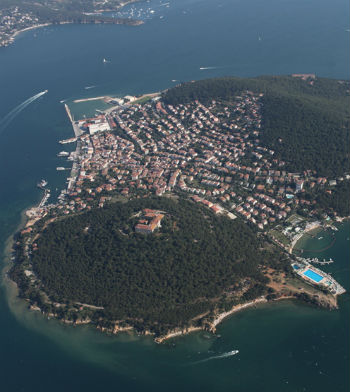
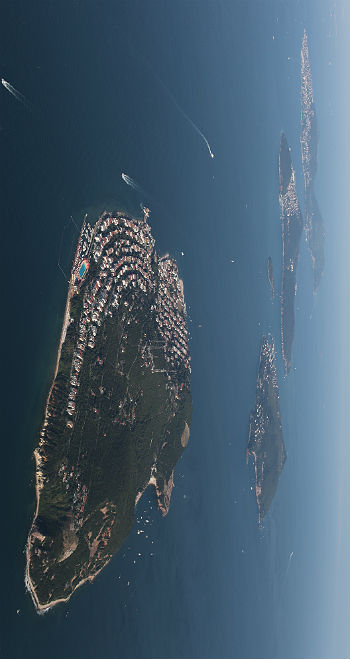
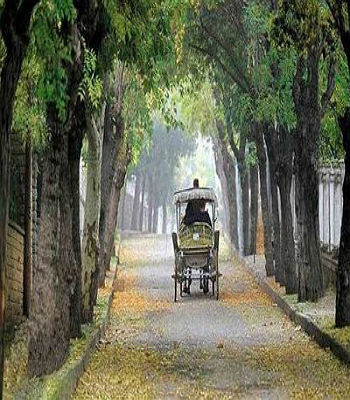
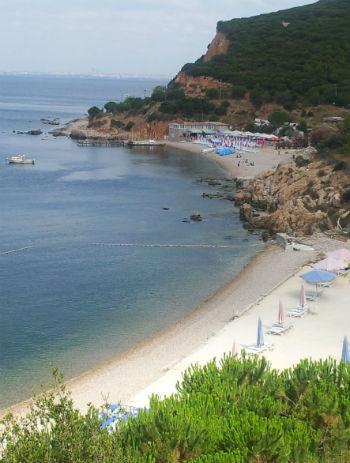
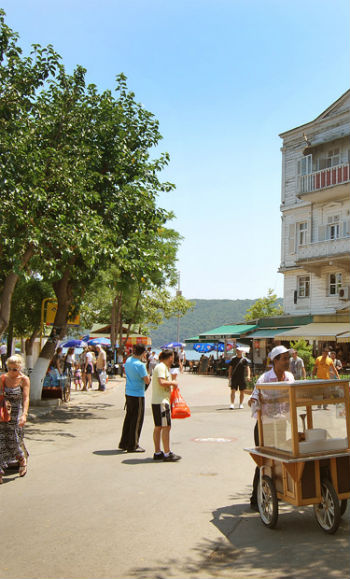
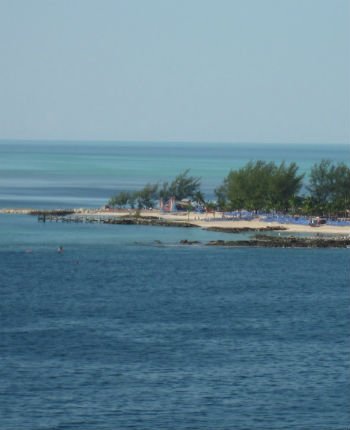
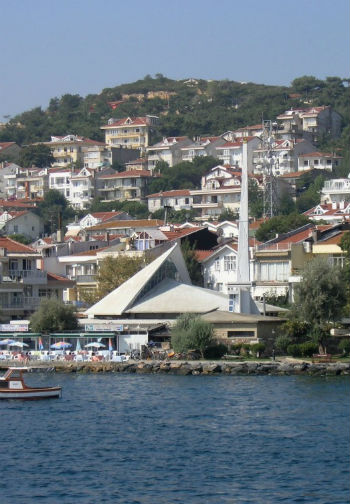
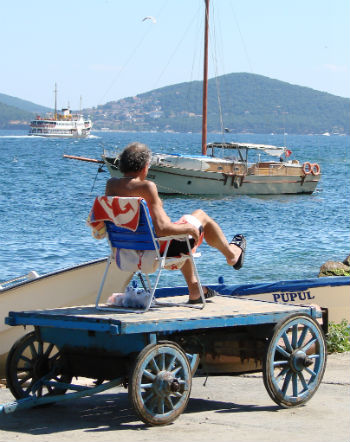
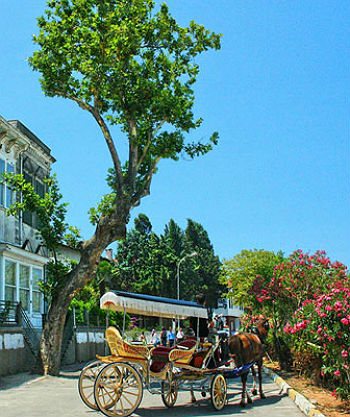
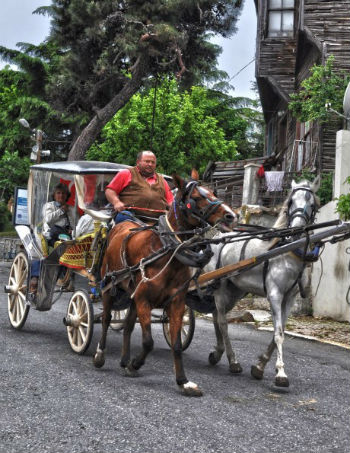
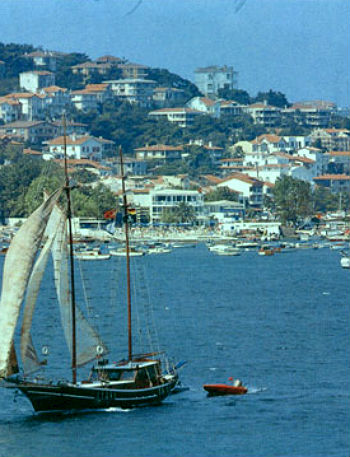
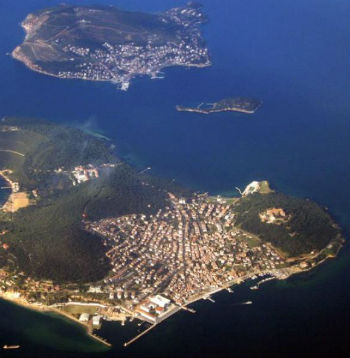
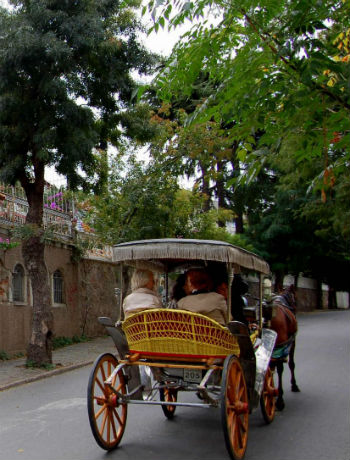
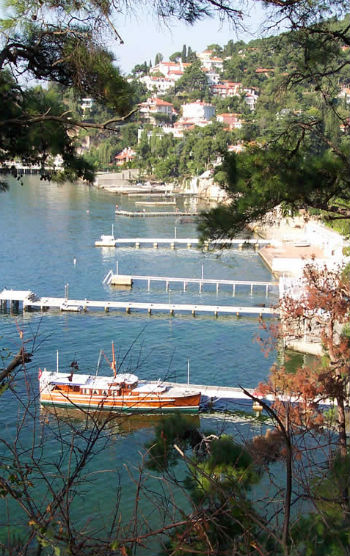
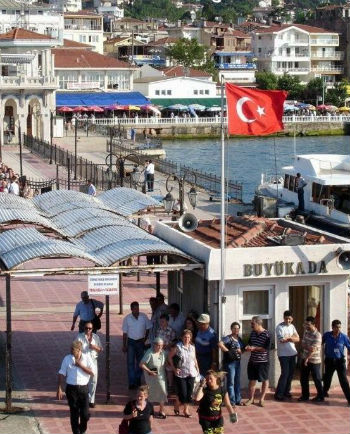
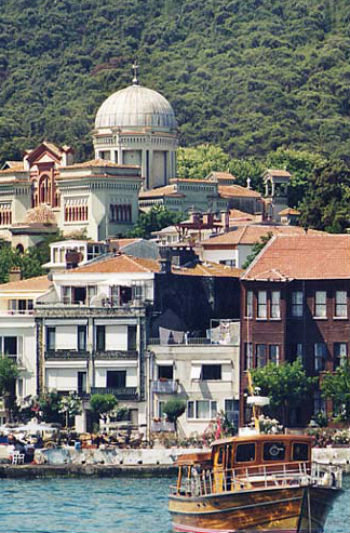
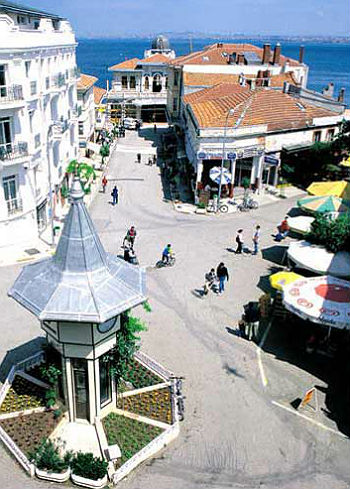
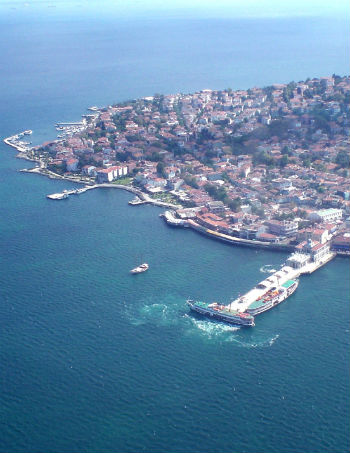
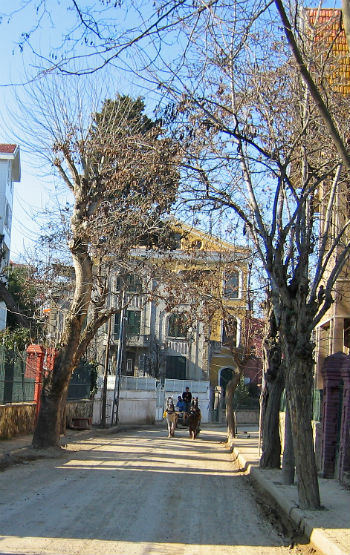
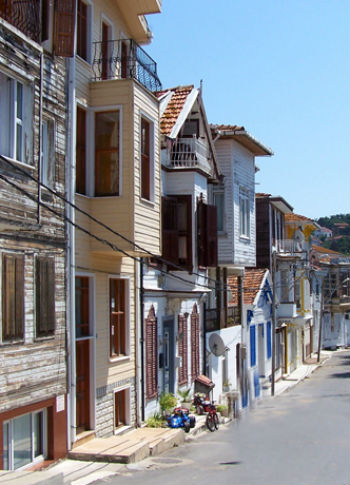
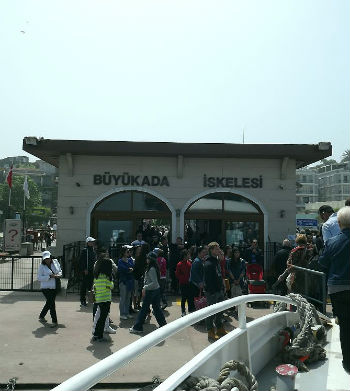
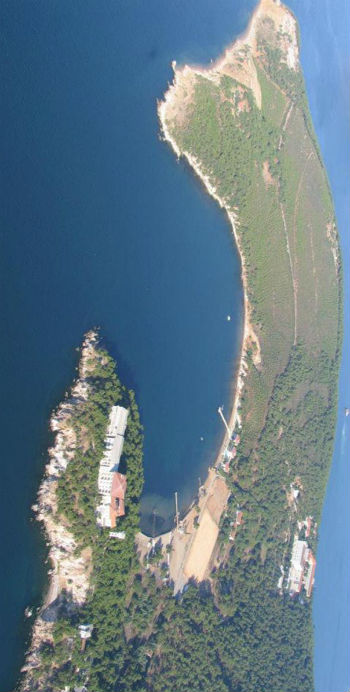


The Princes’ Islands are a chain of nine islands off the coast of Istanbul, Turkey, in the Sea of Marmara. During the summer months the Princes’ Islands are popular destinations for day trips from Istanbul. As there is no traffic on the Islands, the only transport being horse and cart, they are incredibly peaceful compared with the city of Istanbul. They are just a short ferry ride from Istanbul, with ferries departing from Bostanci, Kartal and Maltepe on the Asian side, and from Kabatas on the European side.